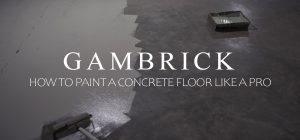
Why Does Concrete Have Lines?
Concrete lines are also called control joints or cuts. When contractors pour concrete, they include these lines in specific places to control and prevent cracks. Then, the control joints are caulked to keep water and foreign materials out. As the concrete dries, shrinks, moves and bears weight, it can crack. Any cracks that form should follow the path of the line, which prevents them in unwanted places like the middle of your sidewalk. Concrete lines are thinner than the rest of the slab which makes them easier to crack. So why does concrete have lines? To control and prevent concrete from cracking in random spots.
Cracks are almost always inevitable when working with large concrete slabs. If the cracks can be controlled by contraction joints, they won’t damage the slab. They also won’t lead to further cracks and breakage in the future because the cracks are controlled.
Builders include control joints in fresh concrete by using saws, grooving tools or materials like strips called zip-strips or felt. Joints should be deep enough to crack as intended which prevents unwanted cracking in other areas.
Concrete lines serve multiple functions, such as crack control, provision of load transfer, and isolation of differently behaving structures. The placement of lines in proper locations is crucial in preventing cracking.
Concrete slabs require reinforcement to provide strength, joints to allow for movement, and a sealant to prevent spalling. By including these elements in your flatwork, you can prevent cracks and other common types of damage.
Benefits of Concrete Lines
Concrete lines, also known as contraction joints, are grooves or lines in the slab. The purpose is to create a weakened plane that controls the location of slab cracking. Moisture warping, temperature curling, thermal contraction, and shrinkage are a few factors that lead to the development of slab cracking.
As concrete carries load, shifts, expands and contracts, pressure builds up. This pressure can crack weak spots in a concrete slab. Without control lines your concrete can crack in random areas throughout the slab and those cracks can then spread. By including control cuts, your concrete should only crack in predetermined areas and those cracks shouldn’t spread.
The orientation of contraction joints is either transverse or longitudinal. The transverse orientation is perpendicular to the traffic flow direction, whereas the longitudinal one is parallel to the traffic flow direction.
Contraction joints and longitudinal construction coincide with travel lane limits. Companies construct transverse construction and contraction joints at locations that produce panels with appropriate dimensions. These joints are usually perpendicular to pavement direction at locations, which line up across adjacent lanes.
Besides, lines also lead to adjacent independent structures. For instance, they allow for median barriers that isolate adjacent structures from the pavement. It is crucial to minimize the potential for cracking by creating lines in the concrete, especially in the embedded structures, such as manholes.
Load Transfer
Concrete payments must transfer traffic loads from one slab to the next. The purpose is to reduce edge a corner stresses or deflections, ensuring satisfactory concrete performance. Lines prevent the development of specific distresses, such as faulting, pumping, cracking, and corner breaks.
Construction companies use the defection-based load transfer efficiency, an important concept that focuses on computing the defections ratio on the loaded and unloaded sides of a joint.
Companies or masonry staff use this when they place the load adjacent to the joint. Besides, they can easily measure joint defections and streamline the load transfer systems on concrete payment performance.
Reduced Shrinkage
Drying shrinkage occurs due to reduced capillary water in the cement paste. Evaporation plays a critical role in concrete shrinkage. The higher amount of water in the concrete is directly proportional to increased shrinkage.
When concrete dries, it shrinks and causes cracks. The professional staff put in contraction joints to prevent cracking, and even if the concrete cracks, it will be at the joints. These areas have the thinnest slab, and even if there are cracks, the concrete won’t look bad.
Control Random Cracking
Cement finishers place contraction joints or lines in concrete slabs to control cracking. Bear in mind that a fresh concrete mixture is a plastic, fluid mass that you can mold into any shape. However, when the material hardens, you will notice a reduction in volume.
When shrinkage is retrained by granular fill, adjoining structures, supporting soils, or reinforcement with the concrete, this can develop tensile stresses within the concrete. Although concrete is more robust in compression, it has a tensile strength of 10-12% of the compressive strength.
Research shows that tensile stresses act against the concrete material, especially at the weakest sections, resulting in cracking. Lines or contraction joints are the most commonly used method to control random cracking in slabs.
It is crucial to place these lines at predetermined locations to create weak planes where the material cracks in a straight line. Not only does this produce an aesthetically attractive appearance, but it also maintains the material’s durability. The reason is that cracks take place below the finished surface.
Summary: Why Does Concrete Have Lines?
Concrete lines are also called control joints or cuts. When contractors pour concrete, they include these lines in specific places to control and prevent cracks. As the concrete dries, shrinks, moves and bears weight, it can crack. Any cracks that form should follow the path of the line which prevents them in unwanted places like the middle of your sidewalk. Concrete lines are thinner than the rest of the slab which means it’s easier to crack. So why does concrete have lines? To control and prevent concrete from cracking in random spots.
Cracks are almost always inevitable when working with large concrete slabs. If the cracks can be controlled by contraction joints, they won’t damage the slab. They also won’t lead to further cracks and breakage in the future because the cracks are controlled.
Builders include control joints in fresh concrete by using saws, grooving tools or materials like strips called zip-strips or felt. Joints should be deep enough to crack as intended which prevents unwanted cracking in other areas.
Concrete lines serve multiple functions, such as crack control, provision of load transfer, and isolation of differently behaving structures. The placement of lines in proper locations is crucial in preventing cracking.
Concrete distress is a common problem that occurs due to improper joint design, construction, and maintenance. These include pumping, spalling, faulting, corner breaks, mid-panel cracking, and blowups. These problems occur due to improper joint construction or excessive joint spacing.
The design, construction, and maintenance are a few factors that contribute to concrete performance. It is crucial to focus on the correct use of lines, layout, and dowels, including their location, size, and alignment to prevent cracks.
Besides, proper joint cutting, periodic inspection, and thorough maintenance also affects the performance of concrete. Experts recommend focusing on appropriate line design, standards, and construction materials to maximize durability and efficiency of your concrete.
If you have any questions or comments about concrete E-mail any time.

John Mazzuca | About | More Posts |
Custom Home Builder
John Mazzuca is a custom home designer and builder at Gambrick with over 25 years experience in the construction industry. John has designed, built and/or remodeled hundreds of homes, small buildings, and commercial projects. He writes about business, real estate, home building, and household electronics. His work has been featured in Fox Business, Better Homes & Garden, House Beautiful, and more.




















